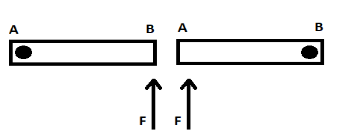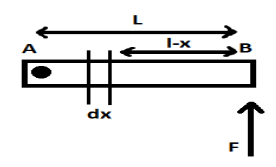
In this figure we see two non-uniform metre stick AB having the linear mass density variation$\lambda = {\lambda _0}x$, where ${\lambda _0}$is a constant and $x$is the distance from end A. It is placed on a smooth horizontal surface.

In the first experiment, the rod is pivoted at A and force F is applied perpendicular to the rod at the other end B and In the second experiment the rod is pivoted at B and the force applied is perpendicular to the rod at the end A. if in the first case angular acceleration is ${\alpha _A}$ and in the second case it is ${\alpha _B}$ then
A. ${\alpha _A} = {\alpha _B}$
B. ${\alpha _A} > {\alpha _B}$
C. ${\alpha _A} < {\alpha _B}$
D. Data insufficient to determine

Answer
558k+ views
Hint: the rotational inertia is calculated around a specific pivot point, which we choose A=0 for calculation and B=l. A non-uniform rod has mass density that varies from one end to another. In rod 1 we can see it is pivoted by the lighter end and rod b is pivoted by heavier end. This information will help us determine the relation between ${\alpha _A},{\alpha _B}$.
Complete step by step answer:
In rod 1 we can see in the figure it is pivoted at A and mass increases as we move towards B.

For rod 1
\[\lambda x = {\lambda _0}\left( {\dfrac{x}{L} + 1} \right)\]\[\]
${I_{rod1}} = \int\limits_{x = 0}^{x = L} {{\lambda _0}} (\dfrac{x}{L} = 1){x^2}dx$
$\Rightarrow{I_{rod1}} = {\lambda _0}{[\dfrac{1}{{4L}}{x^4} + \dfrac{1}{3}{x^3}]^L}_0$
$\Rightarrow {I_{rod1}} = \dfrac{7}{{12}}{\lambda _0}{L^3}$
Now for rod 2, we can see here it is pivoted by its heavier point that is B.

${I_{rod2}} = \int\limits_{x = L}^{x = 0} {dm{{(x - L)}^2}} $
$\Rightarrow{I_{rod2}} = \int\limits_{x = L}^{x = 0} {\lambda (x){{(x - L)}^2}( - dx)}$
Where we know \[\lambda x = {\lambda _0}\left( {\dfrac{x}{L} + 1} \right)\]
$
{I_{rod2}} = \int\limits_{x = 0}^{x = L} {{\lambda _0}} (\dfrac{x}{2} + 1){(x - L)^2}dx \\
\Rightarrow{I_{rod2}} = {\lambda _0}\int\limits_{x = 0}^{x = L} {(\dfrac{{{x^3}}}{L} - {x^2} - xL + {L^2})} dx \\
\Rightarrow{I_{rod2}} = \dfrac{5}{{12}}{\lambda _0}{L^3} \\
$
From this we get to know ${I_{rod2}} < {I_{rod1}}$.
On both the sticks the force applied is the same hence the torque produced will also be the same. Torque is denoted by $\tau = I\alpha $
We know that both the rod are similar and ${\tau _{rod1}} = {\tau _{rod2}}$
${I_{rod1}}{\alpha _A} = {I_{rod2}}{\alpha _B}$
By getting to know that ${I_{rod2}} < {I_{rod1}}$
We can automatically come to conclusion ${\alpha _A} < {\alpha _B}$
Hence, option C is the correct answer.
Note:If the same force is applied on two similar rods, note that magnitude of the torque will always be the same. In case of inequalities, when we have products of two quantities, the relationship remains the same. Thus, in the last step, the relationship between the Inertias will remain the same between $\alpha $.We take into consideration the axis of rotation and the pivot points because the mass density tends to increase when we move away from the origin.
Complete step by step answer:
In rod 1 we can see in the figure it is pivoted at A and mass increases as we move towards B.

For rod 1
\[\lambda x = {\lambda _0}\left( {\dfrac{x}{L} + 1} \right)\]\[\]
${I_{rod1}} = \int\limits_{x = 0}^{x = L} {{\lambda _0}} (\dfrac{x}{L} = 1){x^2}dx$
$\Rightarrow{I_{rod1}} = {\lambda _0}{[\dfrac{1}{{4L}}{x^4} + \dfrac{1}{3}{x^3}]^L}_0$
$\Rightarrow {I_{rod1}} = \dfrac{7}{{12}}{\lambda _0}{L^3}$
Now for rod 2, we can see here it is pivoted by its heavier point that is B.

${I_{rod2}} = \int\limits_{x = L}^{x = 0} {dm{{(x - L)}^2}} $
$\Rightarrow{I_{rod2}} = \int\limits_{x = L}^{x = 0} {\lambda (x){{(x - L)}^2}( - dx)}$
Where we know \[\lambda x = {\lambda _0}\left( {\dfrac{x}{L} + 1} \right)\]
$
{I_{rod2}} = \int\limits_{x = 0}^{x = L} {{\lambda _0}} (\dfrac{x}{2} + 1){(x - L)^2}dx \\
\Rightarrow{I_{rod2}} = {\lambda _0}\int\limits_{x = 0}^{x = L} {(\dfrac{{{x^3}}}{L} - {x^2} - xL + {L^2})} dx \\
\Rightarrow{I_{rod2}} = \dfrac{5}{{12}}{\lambda _0}{L^3} \\
$
From this we get to know ${I_{rod2}} < {I_{rod1}}$.
On both the sticks the force applied is the same hence the torque produced will also be the same. Torque is denoted by $\tau = I\alpha $
We know that both the rod are similar and ${\tau _{rod1}} = {\tau _{rod2}}$
${I_{rod1}}{\alpha _A} = {I_{rod2}}{\alpha _B}$
By getting to know that ${I_{rod2}} < {I_{rod1}}$
We can automatically come to conclusion ${\alpha _A} < {\alpha _B}$
Hence, option C is the correct answer.
Note:If the same force is applied on two similar rods, note that magnitude of the torque will always be the same. In case of inequalities, when we have products of two quantities, the relationship remains the same. Thus, in the last step, the relationship between the Inertias will remain the same between $\alpha $.We take into consideration the axis of rotation and the pivot points because the mass density tends to increase when we move away from the origin.
Recently Updated Pages
Why are manures considered better than fertilizers class 11 biology CBSE

Find the coordinates of the midpoint of the line segment class 11 maths CBSE

Distinguish between static friction limiting friction class 11 physics CBSE

The Chairman of the constituent Assembly was A Jawaharlal class 11 social science CBSE

The first National Commission on Labour NCL submitted class 11 social science CBSE

Number of all subshell of n + l 7 is A 4 B 5 C 6 D class 11 chemistry CBSE

Trending doubts
10 examples of friction in our daily life

One Metric ton is equal to kg A 10000 B 1000 C 100 class 11 physics CBSE

Difference Between Prokaryotic Cells and Eukaryotic Cells

1 Quintal is equal to a 110 kg b 10 kg c 100kg d 1000 class 11 physics CBSE

State the laws of reflection of light

Explain zero factorial class 11 maths CBSE




